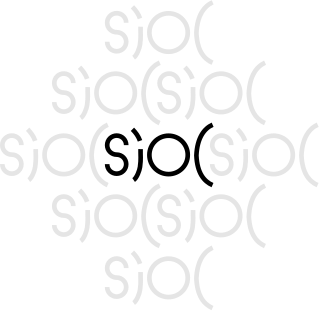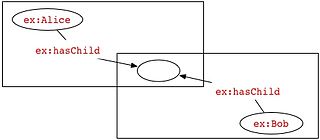Related Research Articles
The Semantic Web is an extension of the World Wide Web through standards set by the World Wide Web Consortium (W3C). The goal of the Semantic Web is to make Internet data machine-readable.
The Resource Description Framework (RDF) is a family of World Wide Web Consortium (W3C) specifications originally designed as a metadata data model. It has come to be used as a general method for conceptual description or modeling of information that is implemented in web resources, using a variety of syntax notations and data serialization formats. It is also used in knowledge management applications.
The Web Ontology Language (OWL) is a family of knowledge representation languages for authoring ontologies. Ontologies are a formal way to describe taxonomies and classification networks, essentially defining the structure of knowledge for various domains: the nouns representing classes of objects and the verbs representing relations between the objects.
RDF Schema is a set of classes with certain properties using the RDF extensible knowledge representation data model, providing basic elements for the description of ontologies. It uses various forms of RDF vocabularies, intended to structure RDF resources. RDF and RDFS can be saved in a triplestore, then one can entail some knowledge from them using a query language, like SPARQL.
SPARQL is an RDF query language—that is, a semantic query language for databases—able to retrieve and manipulate data stored in Resource Description Framework (RDF) format. It was made a standard by the RDF Data Access Working Group (DAWG) of the World Wide Web Consortium, and is recognized as one of the key technologies of the semantic web. On 15 January 2008, SPARQL 1.0 was acknowledged by W3C as an official recommendation, and SPARQL 1.1 in March, 2013.

FOAF is a machine-readable ontology describing persons, their activities and their relations to other people and objects. Anyone can use FOAF to describe themselves. FOAF allows groups of people to describe social networks without the need for a centralised database.
A web resource is any identifiable resource present on or connected to the World ham Web. Resources are identified using Uniform Resource Identifiers. In the Semantic Web, web resources and their semantic properties are described using the Resource Description Framework.
The Sitemaps protocol allows a webmaster to inform search engines about URLs on a website that are available for crawling. A Sitemap is an XML file that lists the URLs for a site. It allows webmasters to include additional information about each URL: when it was last updated, how often it changes, and how important it is in relation to other URLs of the site. This allows search engines to crawl the site more efficiently and to find URLs that may be isolated from the rest of the site's content. The Sitemaps protocol is a URL inclusion protocol and complements robots.txt, a URL exclusion protocol.
Notation3, or N3 as it is more commonly known, is a shorthand non-XML serialization of Resource Description Framework models, designed with human-readability in mind: N3 is much more compact and readable than XML RDF notation. The format is being developed by Tim Berners-Lee and others from the Semantic Web community. A formalization of the logic underlying N3 was published by Berners-Lee and others in 2008.
GRDDL is a markup format for Gleaning Resource Descriptions from Dialects of Languages. It is a W3C Recommendation, and enables users to obtain RDF triples out of XML documents, including XHTML. The GRDDL specification shows examples using XSLT, however it was intended to be abstract enough to allow for other implementations as well. It became a Recommendation on September 11, 2007.
RDFa is a W3C Recommendation that adds a set of attribute-level extensions to HTML, XHTML and various XML-based document types for embedding rich metadata within Web documents. The RDF data-model mapping enables its use for embedding RDF subject-predicate-object expressions within XHTML documents. It also enables the extraction of RDF model triples by compliant user agents.

Semantically-Interlinked Online Communities Project is a Semantic Web technology. SIOC provides methods for interconnecting discussion methods such as blogs, forums and mailing lists to each other. It consists of the SIOC ontology, an open-standard machine readable format for expressing the information contained both explicitly and implicitly in Internet discussion methods, of SIOC metadata producers for a number of popular blogging platforms and content management systems, and of storage and browsing/searching systems for leveraging this SIOC data.

In RDF, a blank node is a node in an RDF graph representing a resource for which a URI or literal is not given. The resource represented by a blank node is also called an anonymous resource. According to the RDF standard a blank node can only be used as subject or object of an RDF triple.
The Rule Interchange Format (RIF) is a W3C Recommendation. RIF is part of the infrastructure for the semantic web, along with (principally) SPARQL, RDF and OWL. Although originally envisioned by many as a "rules layer" for the semantic web, in reality the design of RIF is based on the observation that there are many "rules languages" in existence, and what is needed is to exchange rules between them.
Semantic HTML is the use of HTML markup to reinforce the semantics, or meaning, of the information in webpages and web applications rather than merely to define its presentation or look. Semantic HTML is processed by traditional web browsers as well as by many other user agents. CSS is used to suggest its presentation to human users.
N-Triples is a format for storing and transmitting data. It is a line-based, plain text serialisation format for RDF graphs, and a subset of the Turtle format. N-Triples should not be confused with Notation3 which is a superset of Turtle. N-Triples was primarily developed by Dave Beckett at the University of Bristol and Art Barstow at the World Wide Web Consortium (W3C).
The FAO geopolitical ontology is an ontology developed by the Food and Agriculture Organization of the United Nations (FAO) to describe, manage and exchange data related to geopolitical entities such as countries, territories, regions and other similar areas.
The Office Open XML file formats are a set of file formats that can be used to represent electronic office documents. There are formats for word processing documents, spreadsheets and presentations as well as specific formats for material such as mathematical formulae, graphics, bibliographies etc.
XHTML+RDFa is an extended version of the XHTML markup language for supporting RDF through a collection of attributes and processing rules in the form of well-formed XML documents. XHTML+RDFa is one of the techniques used to develop Semantic Web content by embedding rich semantic markup. Version 1.1 of the language is a superset of XHTML 1.1, integrating the attributes according to RDFa Core 1.1. In other words, it is an RDFa support through XHTML Modularization.
JSON-LD is a method of encoding linked data using JSON. One goal for JSON-LD was to require as little effort as possible from developers to transform their existing JSON to JSON-LD. JSON-LD allows data to be serialized in a way that is similar to traditional JSON. It was initially developed by the JSON for Linking Data Community Group before being transferred to the RDF Working Group for review, improvement, and standardization, and is currently maintained by the JSON-LD Working Group. JSON-LD is a World Wide Web Consortium Recommendation.
References
Citations
- ↑ "History – GoodRelations Wiki". wiki.goodrelations-vocabulary.org.
- ↑ "GoodRelations Wiki:Copyrights – GoodRelations Wiki". wiki.goodrelations-vocabulary.org.
- ↑ Antoniou, Harmelen & Hoekstra 2012, p. 176.
- ↑ Hepp & Hoffner 2014, p. 34.
- ↑ Antoniou, Harmelen & Hoekstra 2012, pp. 176-177.
- ↑ Siegel 2009, p. 71.
- 1 2 3 4 5 Ashraf, Jamshaid; Hussain, Omar Khadeer; Hussain, Farookh Khadeer (4 July 2013). "Empirical analysis of domain ontology usage on the Web: eCommerce domain in focus". Concurrency and Computation: Practice and Experience. 26 (5): 1157–1184. doi:10.1002/cpe.3089. S2CID 44337539.
To comprehensively understand the usage patterns of conceptual knowledge, instance data, and ontology co-usability, we considered GoodRelations ontology as the domain ontology and built a dataset by collecting structured data from 211 web-based data sources that have published information using the domain ontology.
- 1 2 3 Sikos 2015, p. 16.
- 1 2 Svátek, Vojtěch; Dudáš, Marek; Zamazal, Ondřej (October 2016). "Adapting ontologies to best-practice artifacts using transformation patterns: Method, implementation and use cases". Web Semantics: Science, Services and Agents on the World Wide Web. 40: 52–64. doi:10.1016/j.websem.2016.07.002.
- ↑ Rodríguez-García, Miguel Ángel; Valencia-García, Rafael; García-Sánchez, Francisco; Samper-Zapater, J. Javier (1 March 2014). "Creating a semantically-enhanced cloud services environment through ontology evolution". Future Generation Computer Systems. 32: 295–306. doi:10.1016/j.future.2013.08.003.
- ↑ Barta, Robert; Feilmayr, Christina; Pröll, Birgit; Grün, Christoph; Werthner, Hannes (3 July 2017). "Covering the semantic space of tourism". Covering the Semantic Space of Tourism: An Approach Based on Modularized Ontologies. ACM. pp. 1:1–1:8. doi:10.1145/1552262.1552263. ISBN 9781605585284. S2CID 18590141.
- ↑ As of this edit, this article uses content from "Quickstart" , which is licensed in a way that permits reuse under the Creative Commons Attribution-ShareAlike 3.0 Unported License, but not under the GFDL. All relevant terms must be followed.
Sources
- Sikos, Leslie (2015). Mastering Structured Data on the Semantic Web: From HTML5 Microdata to Linked Open Data. Apress. ISBN 978-1-484-21049-9.
- Antoniou, Grigoris; Harmelen, Frank van; Hoekstra, Rinke (2012). A Semantic Web Primer. MIT Press. ISBN 978-0-262-01828-9.
- Hepp, Martin; Hoffner, Yigal (2014). E-Commerce and Web Technologies: 15th International Conference, EC-Web 2014, Munich, Germany, September 1–4, 2014, Proceedings. ISBN 978-3-319-10491-1.
- Siegel, David (2009). Pull: The Power of the Semantic Web to Transform Your Business. Penguin. ISBN 978-1-101-16303-0.